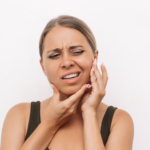
The Top 10 Misconceptions about TMJ Disorder
Temporomandibular joint, TMJ disorder, though widespread, is often misunderstood. This can lead to people not getting the proper treatment they need. As a bioesthetic dentist, I’m here to address these common misconceptions and shed light on temporomandibular joint disorder, helping those suffering from it find relief.
-
TMJ Disorder Only Affects the Jaw
Many people believe temporomandibular joint disorder is confined to the jaw. However the symptoms go beyond the jaw, including headaches, earaches, neck pain, and even shoulder pain. The interconnectedness of the jaw with other parts of the body means that temporomandibular joint issues can manifest in various areas.
-
It’s Always Caused by Teeth Grinding
While teeth grinding (bruxism) is a common cause, it’s not the only one. temporomandibular joint disorder can result from various factors, including arthritis, jaw injuries, misalignment of the teeth or jaw, which can lead to muscle tension around the jaw.
-
TMJ Disorder is Rare
Contrary to this belief, temporomandibular joint disorders are quite common. It’s estimated that over 10 million Americans suffer from TMJ disorders, with a higher prevalence in women than men. However, many cases go undiagnosed due to a lack of awareness.
-
TMJ Disorder is Always Painful
TMJ disorder doesn’t always present with pain. Some individuals experience jaw clicking or popping without discomfort. However, these sounds can indicate underlying issues that may need attention to prevent future problems.
-
There’s Nothing You Can Do About It
Many believe they must simply live with temporomandibular joint disorder. This is not true. Treatments range from dental interventions such as bite guards or orthodontics to bite rejuvenation and orthodontics. Sometimes we can utilize the help of adjunctive treatment such as myofunctional therapy
-
All Jaw Pain is TMJ Disorder
Not all jaw pain is related to temporomandibular joint disorder. Jaw pain can stem from other conditions such as sinus problems, dental abscesses, or neuralgia. A thorough examination by a dentist or healthcare provider is necessary to pinpoint the exact cause.
-
Surgery is the Only Effective Treatment
Surgery is typically considered a last resort only after other treatments have failed. Many patients find relief through non-invasive treatments such as myofunctional therapy, or dental appliances designed to correct bite issues.
-
You Can Diagnose Temporomandibular Joint Disorder Yourself
Self-diagnosis is risky. While certain symptoms might suggest temporomandibular joint disorder, only a professional evaluation can confirm the diagnosis. A dentist or specialist will use a combination of physical examination, medical history, and imaging studies to diagnose TMJ disorder accurately.
-
It is a Result of Poor Oral Hygiene
While maintaining good oral hygiene is crucial for overall health, TMJ disorder is not caused by poor oral hygiene. Its causes are more related to mechanical issues, stress, and sometimes systemic diseases, rather than hygiene practices.
-
TMJ Disorder Will Go Away on Its Own
Some believe temporomandibular joint disorder will resolve without intervention. While some mild cases may improve with self-care and lifestyle changes, most require professional treatment to prevent chronic pain and functional impairment.
Final Thoughts from this Bioesthetic Dentist
Understanding temporomandibular joint disorder is essential for proper diagnosis and treatment. If you suspect you have an issue, schedule an appointment so I can provide a comprehensive evaluation and tailor a treatment plan to address your specific needs. By debunking these misconceptions, my bioesthetic dentist’s office in Burlington can help you find the relief you deserve.
Schedule an Appointment for TMJ Disorder
Your journey to a pain-free life starts with the right knowledge and professional care. Send a message or make the call and schedule an appointment today.



